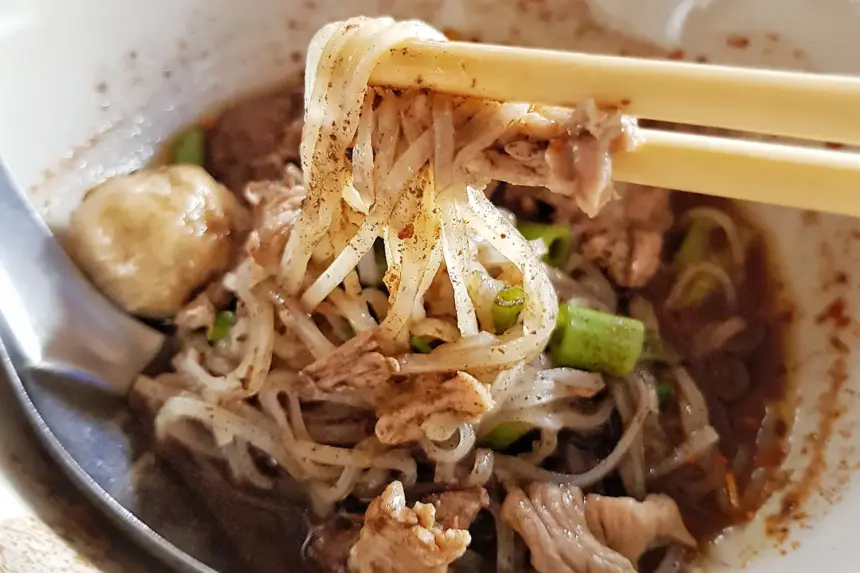Thai Food: Kuay Teow (ก๋วยเตี๋ยว)
Kuay Teow (ก๋วยเตี๋ยว), or Thai noodle soup, is a beloved dish in Thailand that captures the heart of Thai culinary culture. This versatile and flavorful noodle soup can be found on street corners, in restaurants, and even in homes throughout the country. The dish is deeply rooted in Thai and Chinese culture and has evolved over centuries, with many variations and unique regional flavors. Whether you’re in the mood for something savory, spicy, or sweet, there is a Kuay Teow dish that will satisfy your cravings.
In this article, we’ll explore the history and origins of Kuay Teow, the different types of noodles used, popular variations, the preparation process, and its significance in Thai culture. We’ll also discuss how you can make Kuay Teow at home to experience a taste of Thailand wherever you are.
The Origins and Evolution of Kuay Teow
Kuay Teow has its roots in Chinese cuisine, as noodles were first introduced to Thailand by Chinese immigrants centuries ago. Over time, the Thai people adapted these noodles to fit their own tastes and preferences, blending them with local herbs, spices, and ingredients. This fusion of flavors has led to the creation of Kuay Teow as we know it today—a Thai dish with a distinctive identity and a wide range of variations.
The term “Kuay Teow” itself is derived from the Chinese words for “noodle,” indicating the dish’s strong Chinese influence. Initially popular among the Chinese communities in Thailand, Kuay Teow quickly spread throughout the country and became a staple in Thai cuisine. The dish has evolved to incorporate a wide array of flavors and styles, with each region in Thailand offering its unique take on the classic noodle soup.
Types of Noodles in Kuay Teow
One of the defining features of Kuay Teow is the variety of noodles that can be used. Here are some of the most common types of noodles found in Thai noodle soup:
- Sen Lek (เส้นเล็ก): Medium-width rice noodles that are soft and slightly chewy. These noodles are one of the most popular choices for Kuay Teow.
- Sen Yai (เส้นใหญ่): Wide, flat rice noodles that have a smooth texture and are ideal for absorbing the flavors of the broth. These noodles are often used in stir-fried noodle dishes as well.
- Sen Mee (เส้นหมี่): Thin rice vermicelli noodles that are delicate and light. They provide a different texture to the soup and are popular among those who prefer a lighter meal.
- Ba Mee (บะหมี่): Egg noodles that have a firm, springy texture. Ba Mee is made with wheat flour and eggs, giving it a slightly different taste and color compared to rice noodles.
- Woon Sen (วุ้นเส้น): Glass noodles made from mung bean starch. These noodles are translucent and absorb the flavors of the soup, making them a popular choice for those who enjoy a soft, silky texture.
Popular Variations of Kuay Teow
Kuay Teow is an incredibly versatile dish with numerous variations to suit different tastes and preferences. Here are some of the most popular types of Kuay Teow you’ll encounter in Thailand:
- Kuay Teow Nam Sai (ก๋วยเตี๋ยวน้ำใส):
- This is a clear noodle soup with a light and flavorful broth, typically made with pork, chicken, or beef bones. The broth is seasoned with garlic, white pepper, and coriander root, creating a simple yet delicious soup. Kuay Teow Nam Sai is often served with thin slices of meat, meatballs, and fresh vegetables.
- Kuay Teow Nam Tok (ก๋วยเตี๋ยวน้ำตก):
- This rich and hearty noodle soup features a dark, flavorful broth made with pork or beef and infused with blood to give it a unique depth of flavor. The name “Nam Tok” means “waterfall,” which refers to the broth’s dark color and intense taste. Kuay Teow Nam Tok is typically served with fresh herbs, bean sprouts, and a dash of chili for added heat.
- Kuay Teow Tom Yum (ก๋วยเตี๋ยวต้มยำ):
- Inspired by the famous Tom Yum soup, this version of Kuay Teow features a tangy and spicy broth flavored with lemongrass, kaffir lime leaves, galangal, and chili. The dish is often served with shrimp, but pork or chicken can also be used. Kuay Teow Tom Yum is perfect for those who enjoy a sour and spicy flavor profile.
- Kuay Teow Ruea (ก๋วยเตี๋ยวเรือ):
- Also known as “boat noodles,” this dish originated from vendors who sold noodles from boats on the canals of Bangkok. Kuay Teow Ruea is known for its thick, aromatic broth made with pork or beef, spices, and sometimes a small amount of blood to enhance the flavor. The dish is often served in small bowls, and it’s common to enjoy several bowls in one sitting.
- Kuay Teow Moo Daeng (ก๋วยเตี๋ยวหมูแดง):
- This variation features slices of tender red BBQ pork (moo daeng) served over noodles with a light, savory broth. The pork is marinated and roasted to perfection, giving it a slightly sweet and smoky flavor. Kuay Teow Moo Daeng is often garnished with fresh herbs and crispy garlic for added texture.
- Kuay Teow Gai (ก๋วยเตี๋ยวไก่):
- This chicken noodle soup is a comforting and mild dish, often featuring a clear broth made from chicken bones. The chicken is cooked until tender, and the soup is seasoned with garlic, white pepper, and cilantro for a simple yet delicious flavor. Kuay Teow Gai is a favorite among those who prefer a lighter, less spicy noodle soup.
Preparing Kuay Teow
While each variation of Kuay Teow has its unique preparation process, there are some general steps that apply to most versions of the dish. Here’s a basic outline of how Kuay Teow is typically prepared:
- Preparing the Broth:
- The broth is the heart of Kuay Teow and is usually made by simmering bones (chicken, pork, or beef) with aromatics such as garlic, coriander root, and white pepper. For richer versions like Nam Tok and Ruea, additional ingredients like blood, soy sauce, and spices may be added to enhance the flavor.
- Cooking the Noodles:
- The noodles are cooked separately from the broth and are often blanched in boiling water for a few seconds until they are just tender. Once cooked, the noodles are drained and placed in a bowl, ready to be topped with broth and other ingredients.
- Adding Meat and Toppings:
- Depending on the type of Kuay Teow, various meats (sliced pork, chicken, beef, or shrimp) and toppings (meatballs, fresh herbs, bean sprouts, and fried garlic) are added to the bowl. The ingredients are carefully arranged to create a visually appealing and flavorful dish.
- Seasoning to Taste:
- Thai noodle soup is typically served with a range of condiments, including chili flakes, fish sauce, sugar, and vinegar, allowing diners to customize the flavor to their liking. This personalized approach to seasoning is one of the unique aspects of Kuay Teow and Thai cuisine in general.
Kuay Teow and Thai Culture
Kuay Teow holds a special place in Thai culture as a popular comfort food and a reflection of the country’s diverse culinary heritage. The dish is enjoyed by people of all ages and backgrounds, from schoolchildren grabbing a quick bowl on their way home to office workers savoring a late-night meal at a street food stall. In many ways, Kuay Teow represents the communal nature of Thai dining, where food is shared, savored, and adapted to suit individual tastes.
The popularity of Kuay Teow has also led to the rise of specialized noodle shops, where skilled cooks prepare each bowl to order, ensuring that every serving is fresh and delicious. These noodle shops are often family-owned businesses, passed down through generations, and have become an integral part of Thai communities.
How to Make Kuay Teow at Home
Making Kuay Teow at home is a rewarding experience that allows you to enjoy the flavors of Thailand wherever you are. Here’s a basic recipe to get you started:
Ingredients:
- 1 pound chicken or pork bones
- 6 cups water
- 3 cloves garlic, smashed
- 2 coriander roots, cleaned
- 1 teaspoon white peppercorns
- 1 tablespoon soy sauce
- 1 tablespoon fish sauce
- 1 tablespoon sugar
- 200 grams rice noodles (Sen Lek, Sen Yai, or Sen Mee)
- 200 grams sliced pork, chicken, or shrimp
- Fresh bean sprouts, Thai basil, and cilantro for garnish
- Chili flakes, fish sauce, and vinegar for seasoning
Instructions:
- In a large pot, combine the bones, water, garlic, coriander roots, and white peppercorns. Bring to a boil, then reduce heat and simmer for about 1 hour to create a flavorful broth.
- Strain the broth and return it to the pot. Season with soy sauce, fish sauce, and sugar. Adjust seasoning to taste.
- Cook the noodles according to package instructions. Drain and place in serving bowls.
- Blanch the sliced meat in the broth until fully cooked, then place it over the noodles.
- Ladle the hot broth over the noodles and meat. Garnish with bean sprouts, Thai basil, and cilantro.
- Serve with chili flakes, fish sauce, and vinegar for seasoning.
Conclusion
Kuay Teow is more than just a noodle soup; it’s a dish that embodies the rich culinary heritage of Thailand and the influence of Chinese cuisine. From its origins to the diverse variations found across the country, Kuay Teow has become a beloved comfort food that brings people together. Whether you’re exploring the vibrant street food scene in Bangkok or trying your hand at making it at home, Kuay Teow offers a delicious and authentic taste of Thailand that will leave you craving more.










